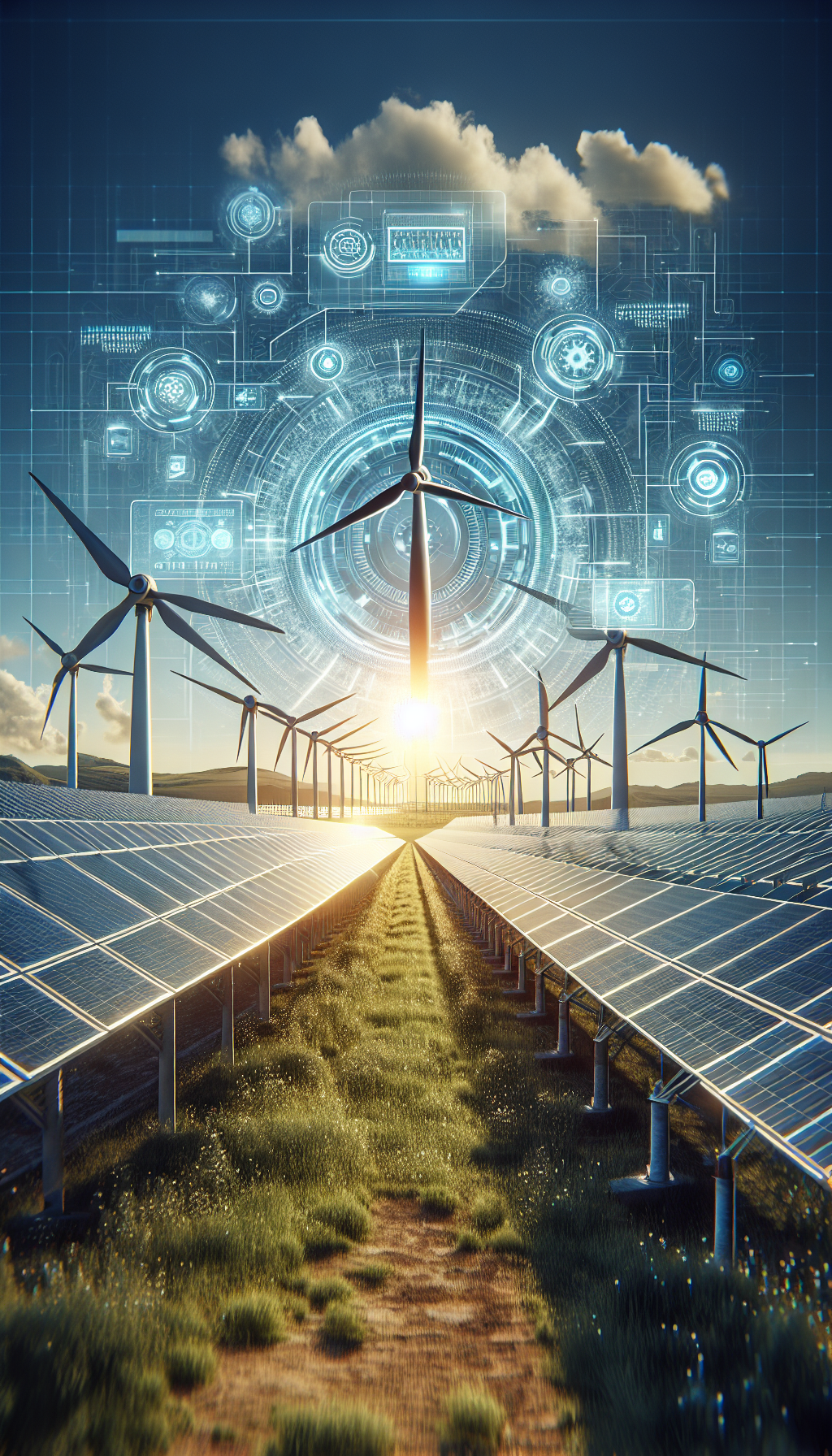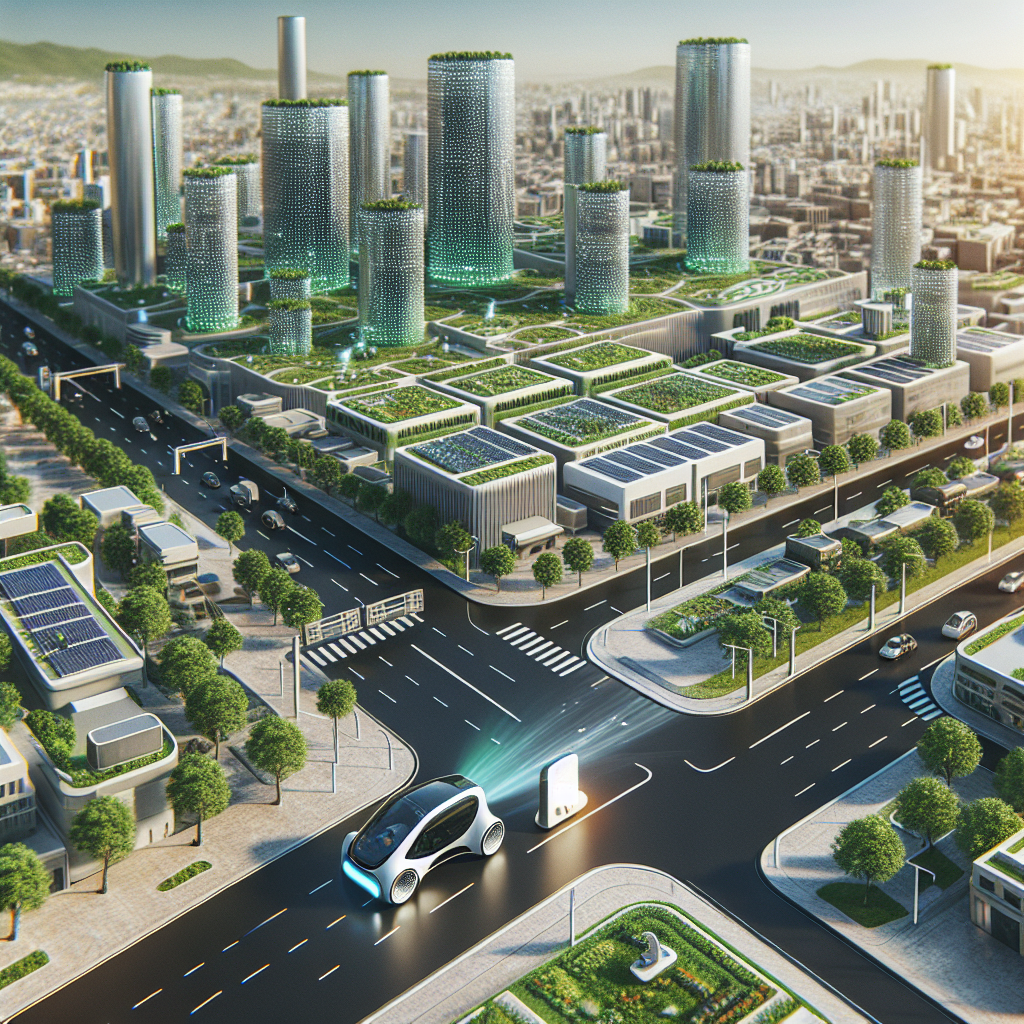AI in Solar Energy Optimization
Artificial Intelligence (AI) is playing a pivotal role in optimizing solar energy systems by improving efficiency and reducing costs. One of the key areas where AI is making a significant impact is in the prediction of solar power generation. By analyzing vast amounts of meteorological data, AI algorithms can accurately forecast solar irradiance, allowing solar farms to optimize energy production. This not only ensures a steady supply of electricity but also helps in better grid management.
Machine learning models are employed to enhance the performance of photovoltaic (PV) systems. These models analyze patterns and predict potential faults in solar panels, enabling predictive maintenance. This proactive approach minimizes downtime and extends the lifespan of solar installations. Furthermore, AI algorithms are used to adjust the angle of solar panels in real-time, maximizing energy absorption throughout the day.
AI also aids in the management of energy storage solutions, which are crucial for solar energy systems. With the integration of AI, energy storage can be optimized to ensure that excess energy generated during peak sunlight hours is efficiently stored and used during periods of low sunlight. This not only enhances the reliability of solar energy but also contributes to a more resilient energy grid.
Incorporating AI in solar energy systems is also beneficial for the financial aspect of renewable energy projects. The use of AI-driven analytics allows for more accurate financial modeling and risk assessment, which can attract more investment into the sector. As a result, solar energy becomes a more viable option for both large-scale operations and individual consumers seeking sustainable energy solutions.
Enhancing Wind Energy Forecasting
The integration of AI in wind energy forecasting is a game-changer for the renewable energy sector. By leveraging machine learning algorithms, it is possible to predict wind patterns with unprecedented accuracy. This capability is crucial as it allows operators to optimize the performance of wind farms, ensuring that energy production is maximized even in fluctuating weather conditions. AI models can analyze vast datasets, including historical weather data and real-time sensor inputs, to generate precise forecasts that guide operational decisions.
One of the primary benefits of AI-enhanced forecasting is the ability to reduce operational costs. With accurate predictions, maintenance can be scheduled proactively, minimizing downtime and preventing costly repairs. Furthermore, AI systems enable more efficient grid management, as energy providers can better match supply with demand. This optimization leads to a more stable energy grid, reducing reliance on fossil fuels and enhancing the overall sustainability of energy systems.
AI’s impact on wind energy is further amplified through the use of advanced data visualization tools. These tools provide operators with intuitive, real-time insights into wind patterns and turbine performance. For example, wind flow can be visualized using heat maps, enabling quick identification of areas with potential for increased energy capture. Additionally, AI-driven dashboards can display key performance indicators, such as turbine efficiency and energy output, in an easily digestible format. This information empowers decision-makers to implement strategies that maximize energy production while minimizing environmental impact.
In summary, the application of AI in wind energy forecasting is revolutionizing the industry by enhancing predictive accuracy, reducing costs, and facilitating more informed decision-making. Through sophisticated data analysis and visualization, AI not only improves the efficiency of wind farms but also contributes to the broader goal of achieving a sustainable energy future.
Smart Grid Integration with AI
Smart grid integration with AI is becoming a cornerstone of modern renewable energy systems. As energy demands grow and fluctuate, AI technologies enable grids to manage resources more efficiently and reliably. AI-driven smart grids can dynamically adjust energy distribution based on real-time data, ensuring that renewable energy sources like solar and wind are optimally utilized. This integration not only enhances the resilience of the energy grid but also reduces waste and lowers operational costs.
One of the key advantages of AI in smart grids is predictive maintenance. By analyzing data from various grid components, AI can predict potential failures and maintenance needs before they occur. This proactive approach minimizes downtime and extends the lifespan of equipment. For example, sensors embedded in wind turbines can collect data that AI systems analyze to forecast mechanical issues, allowing for timely interventions.
Moreover, AI facilitates better demand-response management. By understanding consumption patterns through machine learning algorithms, smart grids can adjust energy flow to match demand precisely. This capability is crucial during peak usage times when the grid is under stress. AI can direct surplus energy generated from renewable sources to storage systems during low-demand periods, making it available when needed. This optimizes energy use and supports the integration of renewables into the grid.
AI’s role in smart grid integration is further enhanced by its ability to support decision-making processes through comprehensive data analysis. Utilities can leverage AI to simulate various scenarios and outcomes, helping them make informed decisions about grid management and energy distribution. This strategic planning is vital for adapting to changes in energy production and consumption, ensuring a sustainable and efficient energy future.
AI in Energy Storage Solutions
Energy storage solutions are critical in overcoming the intermittent nature of renewable energy sources such as solar and wind. Artificial Intelligence (AI) has played a transformative role in enhancing these solutions, providing smarter and more efficient ways to store and distribute energy. AI algorithms can optimize the charge and discharge cycles of batteries, reducing wear and extending their lifespan. This optimization is crucial for maintaining the economic viability of renewable energy systems.
One of the significant contributions of AI in energy storage is in predictive analytics. By analyzing historical data and weather forecasts, AI can predict periods of high energy production and consumption. This allows for better planning and efficient energy distribution, ensuring that storage systems are neither overcharged nor underutilized. Predictive maintenance powered by AI also helps in identifying potential failures in storage systems before they occur, reducing downtime and maintenance costs.
Integration of AI with storage solutions also facilitates the development of smart grids. Smart grids use AI to dynamically balance the supply and demand of electricity, allowing for seamless integration of renewable energy sources. This adaptability ensures that excess energy produced during peak production times can be stored and redirected when production is low, thus maximizing the utilization of renewable resources. Furthermore, AI-driven smart grids enhance grid reliability and resilience, providing a stable energy supply even in the face of fluctuating renewable energy inputs.
The table below illustrates the impact of AI on different aspects of energy storage solutions:
| Aspect | AI Impact |
|---|---|
| Optimization | Improves charge/discharge cycles and extends battery life |
| Predictive Analytics | Forecasts energy production and consumption for efficient distribution |
| Predictive Maintenance | Identifies potential failures to reduce downtime |
| Smart Grid Integration | Balances supply and demand, enhancing grid reliability |
AI-Driven Hydropower Efficiency
Artificial Intelligence (AI) is making significant strides in enhancing the efficiency of hydropower systems. By integrating AI technologies, hydropower plants can optimize water flow, predict equipment failures, and integrate seamlessly with smart grids. These advancements not only improve the operational efficiency but also contribute to sustainable energy production by minimizing waste and maximizing output.
One of the key areas where AI is making an impact is in predictive maintenance. Using data-driven models, AI can predict potential equipment failures before they occur, allowing for timely maintenance and reducing downtime. This approach not only saves costs but also extends the lifespan of hydropower equipment. For instance, AI algorithms analyze historical data and real-time sensor inputs to detect anomalies in turbine operations, ensuring that components are serviced before a failure happens.
Moreover, AI enhances hydropower efficiency through the optimization of water resource management. AI systems can model and simulate various scenarios to determine the optimal release of water, balancing energy production with ecological and regulatory requirements. By predicting water inflows and outflows, AI helps in maintaining reservoir levels that optimize energy production while also considering environmental impacts. This capability is crucial for regions where water scarcity and ecological preservation are of paramount importance.
| AI Application | Benefit |
|---|---|
| Predictive Maintenance | Reduces downtime and maintenance costs |
| Water Management Optimization | Enhances energy production and ecological balance |
- Integration with smart grids for dynamic energy distribution
- Improved forecasting of energy demand and supply
- Real-time monitoring and control of hydropower systems
Machine Learning for Biomass Energy
Biomass energy stands as a crucial component in the realm of renewable energy, leveraging organic materials from plants and animals to produce heat, electricity, and biofuels. The application of machine learning algorithms in this sector is notably enhancing efficiency and sustainability. By analyzing vast datasets, machine learning models can predict optimal conditions for biomass production, conversion, and consumption, thus minimizing waste and maximizing output.
One of the primary areas where machine learning is making a significant impact is in the optimization of biomass supply chains. These algorithms can process complex variables such as weather patterns, crop yields, and transportation logistics. By doing so, they enable more accurate forecasting and planning, reducing costs and ensuring a more reliable supply of raw materials. The integration of these technologies facilitates a more resilient and adaptive biomass energy infrastructure.
Predictive maintenance is another critical application of machine learning in biomass energy. By monitoring equipment performance in real-time, machine learning models can identify patterns and anomalies that signify potential failures. This proactive approach not only extends the lifespan of machinery but also reduces downtime and maintenance costs. Smart sensors and IoT devices play a pivotal role in this process, feeding continuous data streams into machine learning systems to enhance decision-making and operational efficiency.
Furthermore, the role of machine learning extends to the improvement of biomass conversion processes. Through advanced data analysis, these models optimize parameters such as temperature and pressure during conversion, increasing the yield and quality of the final product. This optimization is essential for developing more sustainable and economically viable biomass energy solutions, further solidifying its role in the global transition towards renewable energy.
AI’s Role in Geothermal Energy
Artificial Intelligence (AI) is playing a pivotal role in enhancing the efficiency and effectiveness of geothermal energy systems. By leveraging AI algorithms, geothermal energy production can be optimized, leading to increased energy output and reduced operational costs. AI’s capabilities in data analysis allow for precise modeling of geothermal reservoirs, enabling more accurate predictions of energy potential. This ensures that energy companies can make informed decisions about where to drill and how to manage geothermal resources sustainably.
One of the significant ways AI contributes to geothermal energy is through predictive maintenance. AI systems can analyze data from sensors placed in geothermal plants to predict equipment failures before they occur. This proactive approach helps in minimizing downtime and maintaining continuous energy production. Moreover, AI’s ability to process vast amounts of data in real-time allows for the constant monitoring of geothermal plant performance, ensuring that operations are always running at optimal efficiency.
AI also aids in the integration of geothermal energy into smart grids. By analyzing consumption patterns and energy production data, AI can help balance the supply and demand, making geothermal energy a more reliable and consistent energy source. This integration is crucial for maximizing the use of renewable energy and reducing reliance on fossil fuels. The following table illustrates the benefits AI brings to geothermal energy:
| AI Application | Benefit |
|---|---|
| Predictive Maintenance | Reduces Downtime and Maintenance Costs |
| Reservoir Modeling | Enhances Energy Output Prediction |
| Smart Grid Integration | Balances Supply and Demand |
Predictive Maintenance for Renewable Plants
Predictive maintenance is a game-changer in the renewable energy sector, offering significant benefits by reducing operational costs and enhancing the efficiency of energy production. By leveraging artificial intelligence, renewable plants can anticipate equipment failures before they occur, allowing for timely interventions that minimize downtime and extend the lifespan of critical components. This proactive approach is particularly beneficial for solar, wind, and hydropower plants, where unexpected equipment failures can lead to substantial financial losses and energy production disruptions.
In solar plants, AI algorithms analyze vast amounts of data from sensors placed on panels and inverters to predict potential failures. This data-driven approach helps in identifying patterns and anomalies that could indicate issues such as panel degradation or inverter faults. Similarly, in wind farms, AI models process data from turbines to forecast maintenance needs, focusing on components like gearboxes and blades that are prone to wear and tear.
| Renewable Sector | AI Application | Benefits |
|---|---|---|
| Solar | Panel and inverter monitoring | Reduced downtime, extended equipment life |
| Wind | Turbine performance analysis | Improved reliability, cost savings |
| Hydropower | Turbine and generator monitoring | Optimized operations, enhanced safety |
In the context of hydropower, AI-driven predictive maintenance is crucial for monitoring the condition of turbines and generators. By analyzing vibration data and other performance metrics, AI systems can predict potential failures, allowing operators to schedule maintenance without disrupting energy production. This not only ensures continuous power generation but also enhances the safety of operations by preventing catastrophic failures.
The integration of AI in predictive maintenance is supported by a variety of data visualization tools that provide operators with clear insights into the health of their equipment. These tools use charts and graphs to display real-time data, making it easier for engineers to identify trends and make informed decisions about maintenance schedules. As AI technology continues to evolve, its predictive maintenance capabilities are expected to become even more sophisticated, further revolutionizing the renewable energy industry.
AI and Energy Consumption Reduction
Artificial Intelligence (AI) is playing a pivotal role in reducing energy consumption across various sectors, significantly impacting the renewable energy landscape. By employing advanced algorithms and machine learning techniques, AI can analyze vast amounts of data to identify patterns and inefficiencies in energy usage. This enables organizations to implement targeted strategies to minimize waste and optimize energy consumption.
One of the key areas where AI contributes to energy reduction is through predictive analytics. By anticipating energy demand and adjusting supply accordingly, AI systems can ensure that energy is consumed more efficiently. For instance, AI can predict peak energy usage times and adjust the operation of renewable energy sources like solar panels and wind turbines to maximize output during these periods. This not only reduces energy waste but also enhances the reliability and stability of the energy grid.
| Energy Source | AI Application | Impact |
|---|---|---|
| Solar | Panel Angle Optimization | Increases efficiency by up to 20% |
| Wind | Dynamic Turbine Adjustment | Boosts output by 15% |
| Hydropower | Flow Rate Prediction | Enhances energy output predictability |
Moreover, AI facilitates the development of smart grids which are instrumental in energy consumption reduction. Smart grids utilize AI algorithms to manage electricity distribution more effectively, balancing supply and demand in real-time. This results in a more resilient and efficient energy system, reducing the need for excess energy production and minimizing environmental impact. Through these innovations, AI is not just transforming how energy is consumed but is also paving the way for a more sustainable future.
AI-Enhanced Renewable Energy Trading
Artificial Intelligence (AI) is playing a pivotal role in transforming renewable energy trading by enhancing efficiency and accuracy in market operations. The integration of AI technologies in trading platforms is enabling more precise predictions of energy supply and demand, thus optimizing the trading process. Machine learning algorithms analyze vast amounts of data from weather forecasts, energy consumption patterns, and market trends to make informed trading decisions. This not only maximizes profits for energy producers but also helps in maintaining a balanced energy grid.
One of the key advantages of AI-enhanced trading is its ability to handle the complexities of real-time energy markets. By leveraging AI, traders can automate the buying and selling of energy based on real-time data, which reduces the latency and human error associated with traditional trading methods. This is particularly beneficial in renewable energy markets where the supply can be unpredictable due to varying weather conditions. AI systems can quickly adapt to these changes, ensuring that energy is traded at the most opportune moments.
Moreover, AI facilitates the development of smart contracts that streamline the execution of trades. These contracts, based on blockchain technology, automatically enforce terms and conditions, reducing the need for intermediaries and lowering transaction costs. As a result, both large-scale energy producers and smaller renewable energy providers can benefit from increased market access and improved transparency.
In addition to optimizing the trading process, AI also contributes to the development of peer-to-peer energy trading platforms. These platforms empower individual energy consumers and producers to trade electricity directly with each other. AI algorithms manage the distribution and pricing of energy, ensuring that transactions are fair and efficient. This innovative approach not only democratizes energy trading but also encourages the adoption of renewable energy sources by making them more accessible to the average consumer.
| Benefits of AI in Renewable Energy Trading |
|---|
|
Future Trends in AI and Renewable Energy
The integration of artificial intelligence into the renewable energy sector is set to accelerate, with several emerging trends poised to redefine the landscape. One significant development is the increased use of machine learning algorithms to enhance energy forecasting accuracy. By analyzing vast datasets, AI can predict energy production levels from renewable sources like solar and wind with unprecedented precision, allowing for better grid management and reduced reliance on fossil fuels. Moreover, AI-driven predictive maintenance is expected to become more sophisticated, minimizing downtime and maintenance costs for renewable energy infrastructures.
Another promising trend is the advancement of smart grid technologies. These intelligent systems, powered by AI, are capable of real-time energy distribution and demand response, optimizing energy usage and storage across various sectors. The deployment of smart grids is anticipated to improve energy efficiency and facilitate the seamless integration of distributed energy resources. Additionally, the role of AI in energy trading is likely to expand, enabling more efficient market operations through automated decision-making processes.
Looking ahead, AI’s role in energy storage solutions is expected to grow. As renewable energy sources are inherently variable, effective storage solutions are crucial for maintaining a stable energy supply. AI can optimize the charging and discharging cycles of batteries, improving their lifespan and efficiency. This advancement will be critical as the demand for renewable energy continues to rise. The following table highlights some key areas where AI is anticipated to make an impact:
| Area | AI Impact |
|---|---|
| Energy Forecasting | Improves accuracy and reliability of energy production predictions |
| Predictive Maintenance | Reduces costs and prevents unexpected failures |
| Smart Grids | Enhances real-time distribution and demand management |
| Energy Storage | Optimizes battery efficiency and lifecycle |
In conclusion, the future of renewable energy is intricately linked with the advancements in AI technologies. As AI continues to evolve, its applications in renewable energy will not only enhance operational efficiencies but also drive the global transition towards sustainable energy solutions. These trends underscore the potential of AI to facilitate a more resilient and sustainable energy future.



